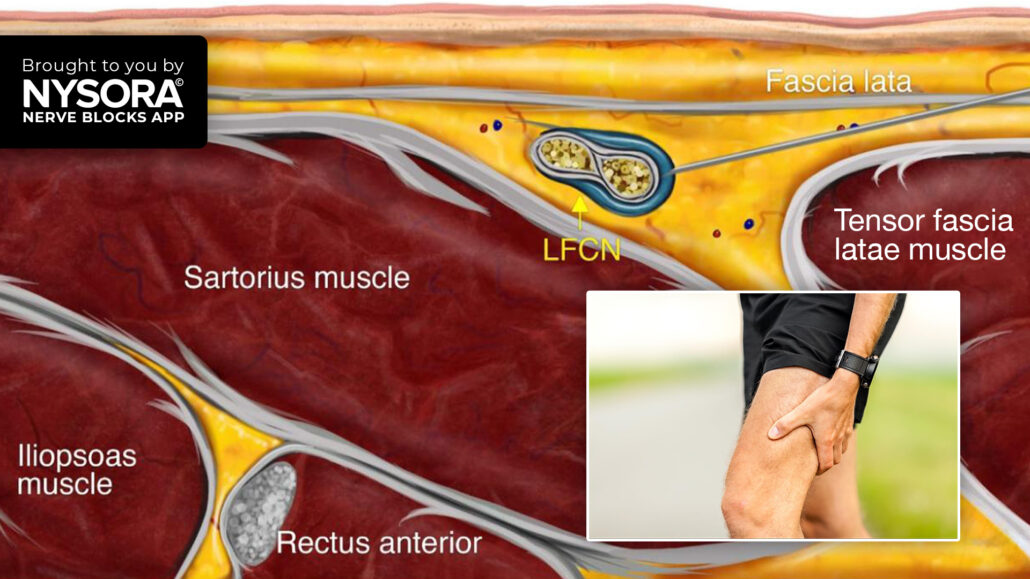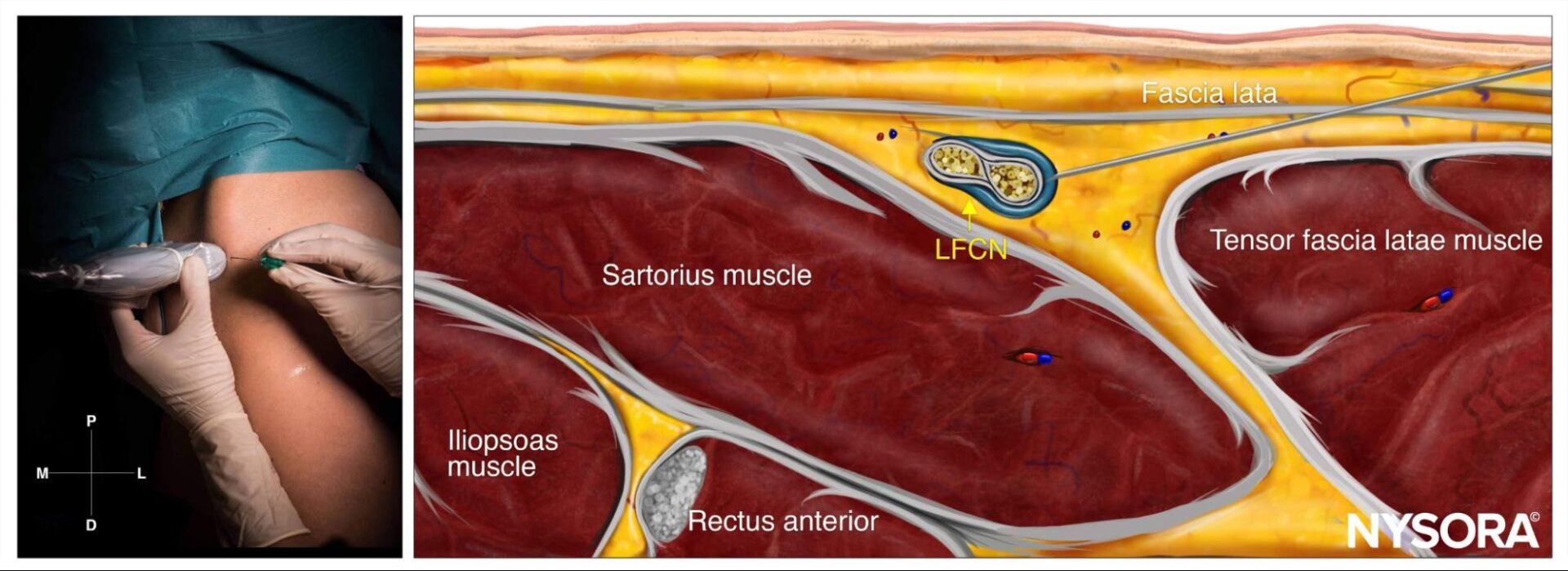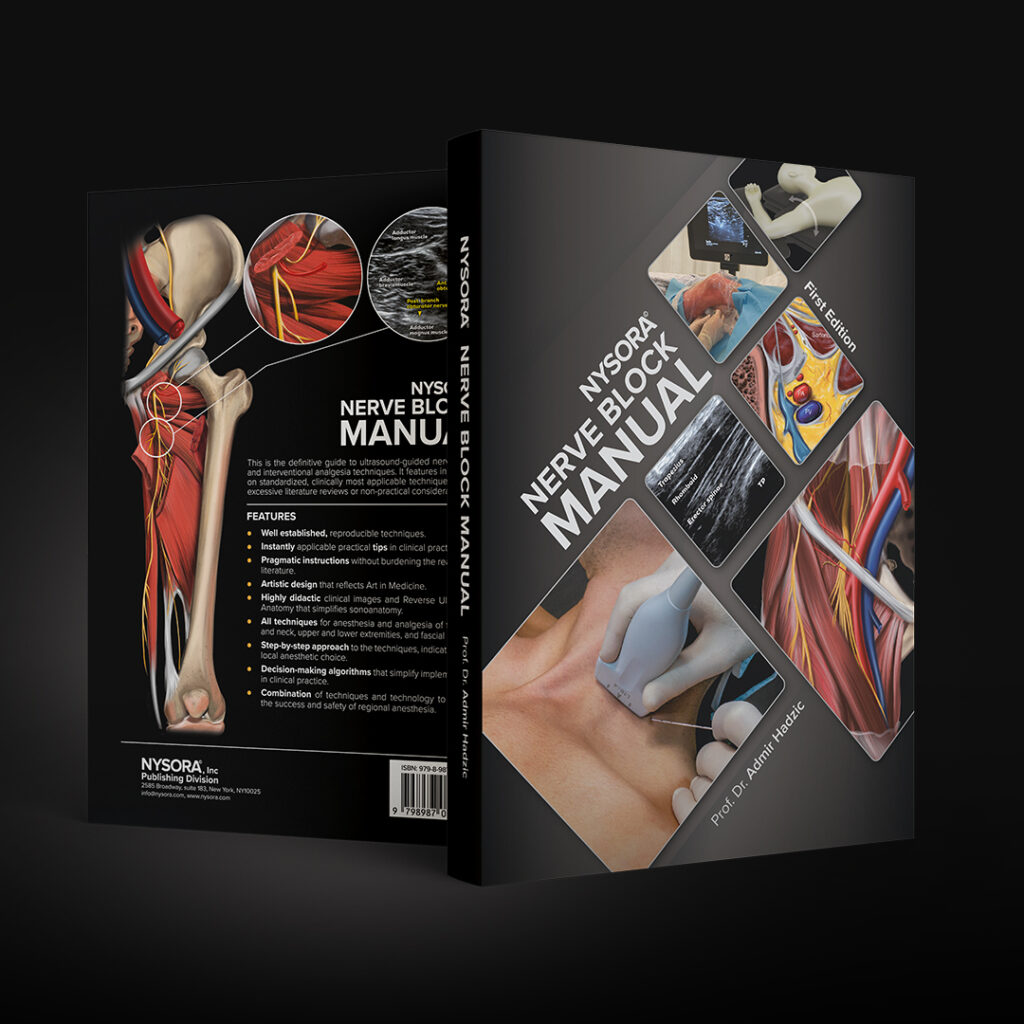
Case study: The utility of a LFCN block in treating meralgia paresthetica
Case presentation
A 46-year-old male patient sought medical attention for burning pain and a tingling sensation in the outer aspect of the right thigh, symptoms typical of meralgia paresthetica, a condition caused by compression of the lateral femoral cutaneous nerve (LFCN). An ultrasound-guided LFCN block was considered to alleviate pain. The diagnosis was confirmed upon physical examination as the patient’s discomfort increased during standing and walking activities. Diagnostic imaging through MRI and ultrasound effectively eliminated other causes of neuropathy.
Nerve block technique
The patient was positioned supine with the lower extremity extended, ensuring optimal access to the proximal thigh for the procedure. The sartorius muscle was identified using a high-frequency linear transducer placed transversely just distal to the anterior superior iliac spine (ASIS). The LFCN appeared as a hyperechoic structure moving superficially to the muscle toward a tiny space between the sartorius and tensor fascia latae muscles.

Transducer position and sonoanatomy for a lateral femoral cutaneous nerve (LFCN) block.
Next, a 25-gauge needle was inserted in-plane deep to the fascia lata next to the nerve to administer the anesthetic solution. The local anesthetic mixture consisted of 5 mL of 0.25% bupivacaine and 1 mL (40 mg) of triamcinolone, effectively targeting the LFCN for pain relief.

Reverse Ultrasound Anatomy for a lateral femoral cutaneous nerve (LFCN) block with needle insertion in-plane and local anesthetic spread (blue).
Patient outcome
The nerve block was completed without complications, and the patient reported a significant reduction in pain and tingling sensation immediately following the injection. The patient experienced substantial relief from the meralgia paresthetica post-procedure, which improved his quality of life and mobility. The effect of the nerve block lasted for several months.
This case study demonstrates the utility of an ultrasound-guided LFCN block in treating meralgia paresthetica, offering an effective alternative to conservative treatment methods. By providing targeted relief, this approach can significantly improve patient symptoms and quality of life.
Continued: Exploring the Role of Ultrasound-Guided LFCN Block in Meralgia Paresthetica
Following the successful treatment of a 46-year-old male patient with meralgia paresthetica using an ultrasound-guided lateral femoral cutaneous nerve (LFCN) block, it is essential to highlight the growing body of evidence supporting this technique. A report published by Kim et al. 2011 in the Korean Journal of Pain also underscores the significant benefits of utilizing ultrasound guidance for LFCN blocks in managing this condition.
Ultrasound-Guided LFCN Block: A Precise and Effective Solution
Meralgia paresthetica, a neuropathy caused by the compression or entrapment of the LFCN, often presents with pain, tingling, or numbness along the outer thigh. Traditional approaches to treat this condition include conservative management such as physical therapy, weight loss, and oral medications. However, when these methods fail, nerve blocks become a crucial option for targeted pain relief.
The use of ultrasound guidance has emerged as a game-changer for performing LFCN blocks. The LFCN, a small sensory nerve, varies anatomically between individuals, making blind nerve blocks less reliable, with failure rates as high as 60%. Ultrasound technology allows clinicians to visualize the nerve and its surrounding structures, ensuring accurate placement of the anesthetic and reducing the risk of complications. This increased precision translates to higher success rates and fewer complications compared to traditional blind blocks.
Case Study
In a notable case report from Daegu Fatima Hospital, a 46-year-old female patient presented with severe pain and paresthesia in the right anterolateral femoral region, classic symptoms of meralgia paresthetica. Despite undergoing various conservative treatments, her symptoms persisted, significantly impairing her quality of life.
The medical team opted for an ultrasound-guided LFCN block:
- Using a high-frequency ultrasound probe, they identified the LFCN as it passed beneath the inguinal ligament, lying above the sartorius muscle.
- A precise injection of a local anesthetic mixture—bupivacaine with triamcinolone—was administered around the nerve.
- The immediate reduction in pain was profound, with the patient’s Visual Analog Scale (VAS) score dropping from 8 to 3 within a week.
- A second injection, utilizing half the initial dosage of anesthetic, further improved the patient’s condition, reducing the VAS score to 0 within four months of treatment.
- Notably, no motor deficits or other complications occurred, a testament to the accuracy and safety of the ultrasound-guided approach.
Advantages of Ultrasound-Guided LFCN Block
- Increased success rate: Studies have demonstrated that ultrasound-guided LFCN blocks are significantly more effective than blind techniques. By
- directly visualizing the nerve, clinicians can ensure the anesthetic is delivered precisely, avoiding common pitfalls associated with anatomical variations of the nerve.
- Reduced anesthetic dosage: With ultrasound guidance, smaller volumes of local anesthetic can be used. This minimizes the risk of systemic toxicity and reduces the likelihood of inadvertently blocking nearby nerves, such as the femoral or obturator nerves.
- Fewer complications: The precision offered by ultrasound reduces the chance of complications, such as nerve injury or incomplete block, while ensuring that the intended nerve is adequately anesthetized.
- Improved patient outcomes: As demonstrated in the case study, ultrasound-guided LFCN blocks provide rapid and long-lasting pain relief for patients suffering from meralgia paresthetica, significantly enhancing their quality of life and mobility.
Broader Implications for Pain Management
The success of ultrasound-guided LFCN blocks for meralgia paresthetica underscores the growing importance of ultrasound technology in pain management. This technique not only increases the precision of nerve blocks but also opens the door to safer, more efficient treatment options for a variety of neuropathic conditions.
Conclusion
The case studies and research surrounding ultrasound-guided LFCN blocks provide compelling evidence for their use in treating meralgia paresthetica. With higher success rates, reduced anesthetic dosages, and fewer complications compared to traditional methods, ultrasound-guided techniques represent the future of nerve block procedures. For patients experiencing debilitating neuropathic pain, this approach offers a targeted, effective solution that can dramatically improve quality of life.
For more detailed information, refer to the full article in The Korean Journal of Pain.
Kim JE, Lee SG, Kim EJ, Min BW, Ban JS, Lee JH. Ultrasound-guided Lateral Femoral Cutaneous Nerve Block in Meralgia Paresthetica. Korean J Pain. 2011;24(2):115-118.
Explore additional case studies and access the comprehensive guide to the 60 most common nerve blocks by downloading the Nerve Blocks App HERE. Don’t miss the opportunity to acquire the bestselling NYSORA Nerve Blocks App, now also available in book format – the ideal study companion to complement the app!




